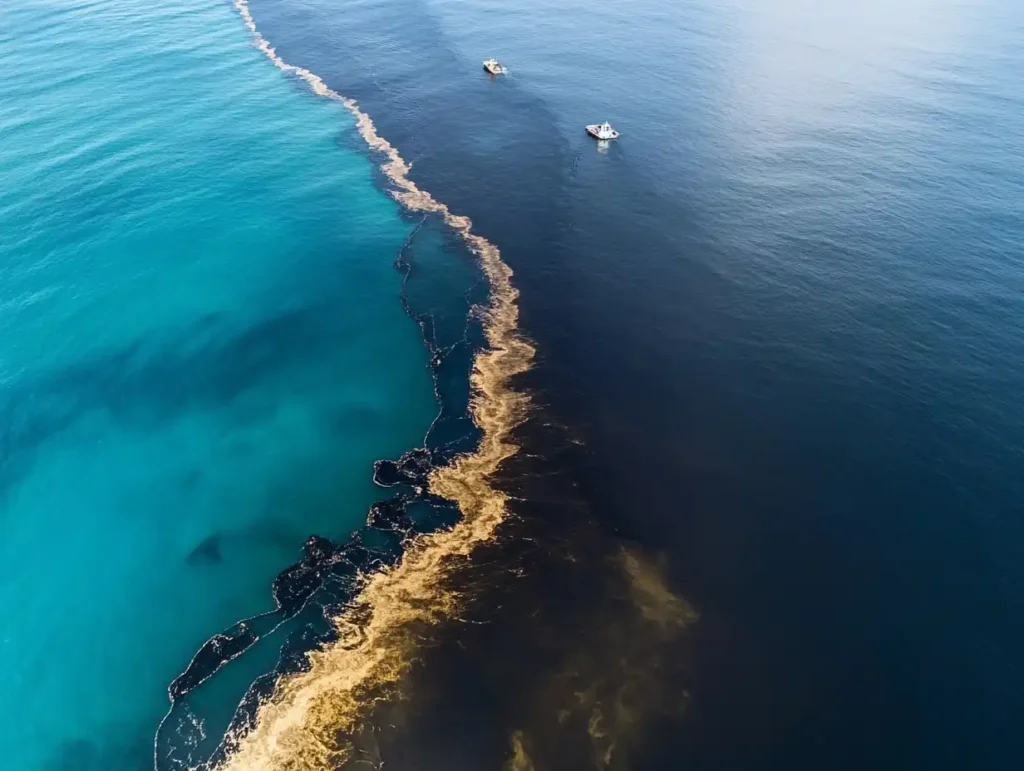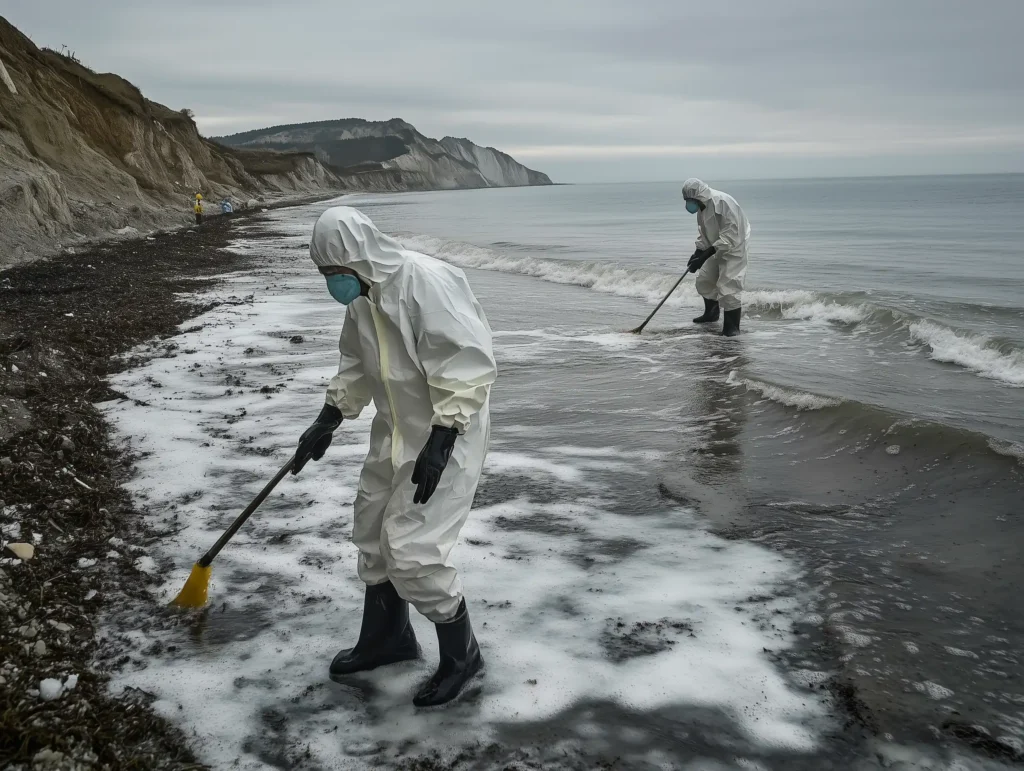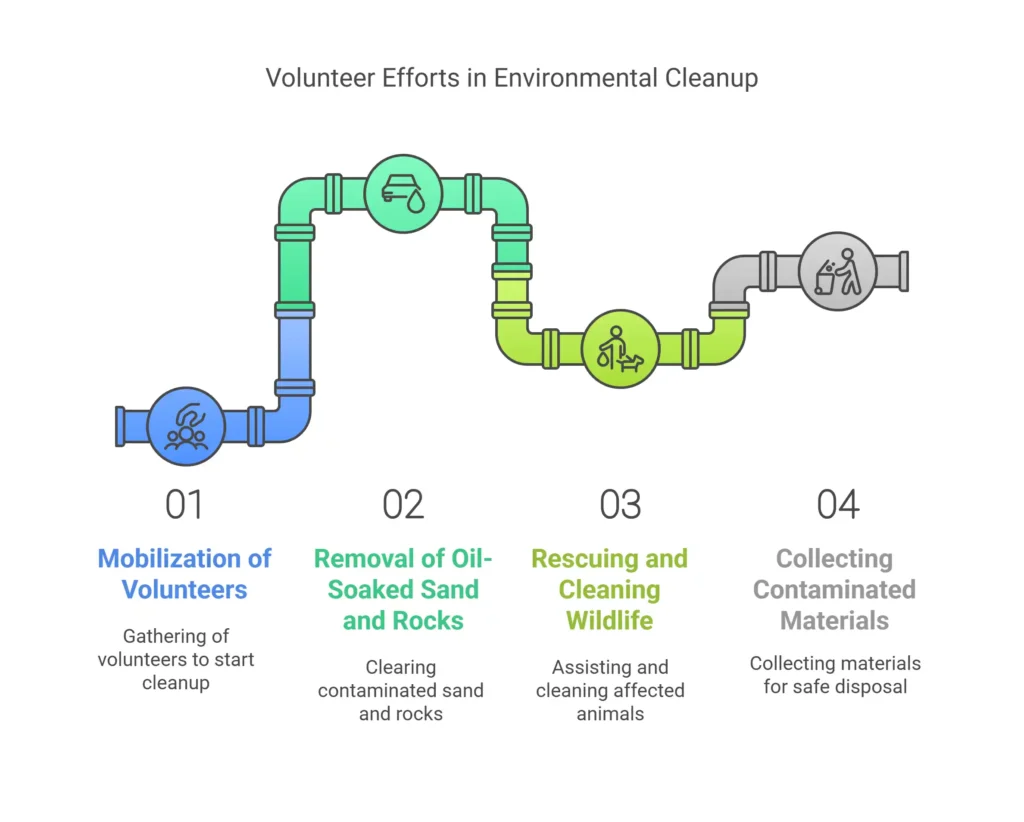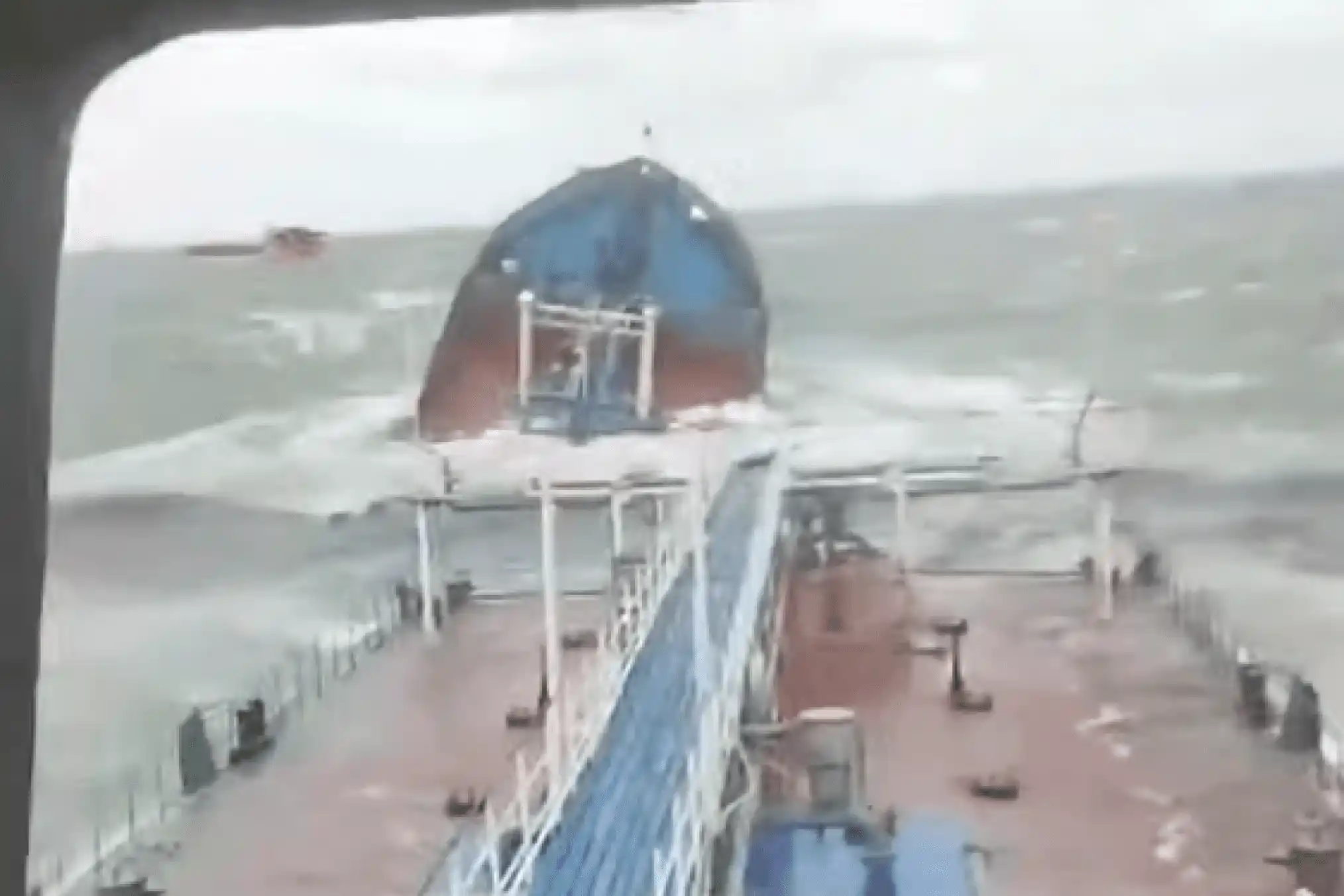The December 2024 oil spill in the Black Sea released thousands of tons of toxic mazut when two aging Russian tankers broke apart during a storm. The thick oil harmed thousands of birds and dozens of dolphins while contaminating miles of coastline. Volunteer cleanup efforts face ongoing challenges as oil continues washing ashore months later. The disaster highlights the dangers of using old vessels to transport hazardous materials and the need for better maritime safety regulations.
Black Sea oil spill, What Happened in the Kerch Strait
On December 15, 2024, a severe storm struck the Kerch Strait, a narrow waterway connecting the Black Sea and the Sea of Azov. Two Russian oil tankers, the Volgoneft-212 and Volgoneft-239, faced powerful waves that proved too much for their aging hulls.
The Volgoneft-212 broke in two and sank, resulting in one crew member death. The Volgoneft-239 ran aground near the port of Taman with significant damage. Both vessels were carrying mazut, a thick, heavy fuel oil used in shipping.
About 3,000 tonnes of mazut spilled into the sea, creating a massive oil slick. The thick oil quickly spread to the coastlines of western Krasnodar Krai, most of Crimea, and parts of the Sea of Azov.
Russian authorities declared a state of emergency as the environmental damage became clear. The spill created one of the worst marine disasters in the region’s recent history.

Why the Tankers Failed
Several factors contributed to this Black Sea oil spill. First, both vessels were extremely old. The Volgoneft-212 was built in 1969, making it 55 years old at the time of the accident. The Volgoneft-239 wasn’t much newer, built in 1973.
These aging tankers had undergone questionable modifications. The Volgoneft-212 had been cut apart and reattached in a 2024 refit, creating a weak point that likely failed during the storm. This type of modification raises serious safety concerns about the vessel’s ability to withstand rough sea conditions.
Furthermore, both ships were reportedly part of Russia’s “shadow fleet” – older vessels used to transport oil while avoiding international sanctions. These ships often operate with less strict safety standards and oversight.
An investigation by Russian authorities found the vessels were:
- Operating beyond their technical capabilities
- Violating seasonal restrictions
- Transporting hazardous cargo without proper licensing
This combination of an aging fleet, questionable modifications, and regulatory failures created perfect conditions for disaster when the storm hit.
Environmental Damage
The mazut spill caused severe environmental harm that continues months after the initial disaster. Unlike lighter oils that can evaporate or break down relatively quickly, mazut is extremely persistent in the environment, according to the International Tanker Owners Pollution Federation.
Wildlife Impact
By early 2025, the spill had killed:
- At least 70 dolphins
- 15,000-20,000 birds
The thick oil coats birds’ feathers, making it impossible for them to fly or stay warm. When animals try to clean themselves, they swallow the toxic oil, causing internal damage. This is just one example of offshore technological impacts on wildlife.
Marine mammals like dolphins suffer when oil blocks their airways or gets ingested while feeding. Smaller marine life, including fish, plankton, and bottom-dwelling creatures, face long-term threats from the contamination.
Black Sea oil spill, Coastal Contamination
The mazut has polluted miles of coastline. By January 2025, cleanup teams had removed over 71,000 tons of contaminated sand and soil from 56 kilometers of shoreline. Officials estimated the total contamination could reach 200,000 tons.
The oil forms sticky globs that cling to rocks, sand, and plants along the shore. These deposits can remain for years, slowly releasing toxins back into the environment during storms or warm weather.

Cleanup Challenges
Cleaning up mazut presents unique difficulties compared to other oil spills. The thick substance doesn’t float well on water – instead, it forms balls that sink to the seabed or stick to everything it touches. These challenges require innovative maritime technologies to address effectively.
Russian officials admitted they had no proven methods for removing mazut from the water column. Most cleanup efforts have focused on removing oil from beaches and coastlines after it washes ashore.

Over 10,000 volunteers have worked tirelessly to clean affected areas. Their efforts include:
- Removing oil-soaked sand and rocks
- Rescuing and cleaning affected wildlife
- Collecting contaminated materials for disposal
However, these volunteers face serious health risks. The mazut contains dangerous chemicals that can cause cancer. Many volunteers have reported headaches, nausea, and breathing problems after exposure to toxic fumes. Health experts from the World Health Organization warn that oil spill cleanup workers need proper protection from these hazardous substances. At least one person may have died from breathing these fumes, and many volunteers needed medical care.
Environmental experts and international observers have strongly condemned Russia’s response as inadequate, delayed, and poorly coordinated. Despite declaring a state of emergency, Russian authorities failed to deploy sufficient resources or accept international assistance offers. Local officials reportedly downplayed the severity of the spill in early communications. Volunteers lack basic protective equipment, specialized tools, and expert guidance, essentially shouldering the burden of a cleanup that should be led by professional teams with proper resources. Meanwhile, oil continues washing ashore months after the spill, with Russian authorities seemingly more concerned about controlling information than addressing the environmental catastrophe. The limited media access to affected areas has also raised questions about the true scale of the disaster.
Legal Consequences
After the spill, Russian authorities opened criminal cases against both ships for maritime safety violations. The captain of the Volgoneft-212 faced additional charges of negligent homicide related to the death of a crew member. These incidents reflect the complex geopolitical tensions that often influence maritime operations.
Both captains were charged on December 18, 2024. The captain of the Volgoneft-212 was placed in investigative custody, while the captain of the Volgoneft-239 was under house arrest.
In March 2025, Kama Shipping, the owner of the Volgoneft-212, was found guilty of violating maritime classification documents. The company was fined ₽30,000 (approximately $215) – a small amount compared to the environmental damage caused.
Legal experts suggest the investigation could continue for many months. Those found responsible could face up to five years in prison for violating maritime safety regulations that led to this major disaster.
Lessons for Maritime Safety
This catastrophe offers important lessons for preventing future oil spills. The Black Sea disaster highlights several critical issues:
- Aging vessels pose serious risks – Ships over 50 years old need thorough inspections and maintenance, or retirement from service. The industry can learn from historical advances in maritime technology.
- Vessel modifications require strict oversight – Major structural changes, like cutting and rewelding ship hulls, need careful engineering and testing.
- “Shadow fleets” need regulation – Vessels operating outside normal regulatory frameworks pose environmental and safety hazards.
- Heavy fuel oils like mazut are particularly dangerous – When spilled, these substances cause long-lasting damage and resist cleanup efforts.
- Rapid response capabilities are essential – Countries need pre-positioned equipment, trained personnel, and clear plans to address spills quickly. Organizations like the National Oceanic and Atmospheric Administration provide guidance on effective oil spill response protocols.
The Black Sea spill serves as a warning about the environmental risks of maritime transport, especially involving older vessels and hazardous substances. As cleanup continues and investigations proceed, the incident reminds us of our responsibility to protect fragile marine environments through better safety standards and stronger enforcement. The maritime industry must embrace digital transformation and smart technologies to prevent such disasters in the future.


Leave a Reply